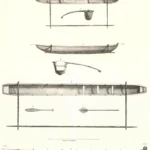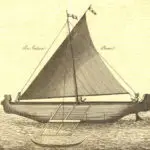Canoe Building


Table of Contents
Share This
Flying proa
A systematic migration to and settlement of the Mariana Islands, about 3,500 years ago, would not have been possible without some degree of sophistication regarding the ancient CHamoru/Chamorro settlers’ construction of seaworthy craft, and their ability to navigate such vessels to and from these islands and their place of origin. As this was the probable case, it follows that the means which enabled their migration, also provided the CHamorus with the foundation for the construction and handling of the CHamoru proa—the sailing vessels so renowned and praised by Europeans who encountered it in the 16th through 18th centuries.
Scarce information
Despite the distinctiveness of the natives’ sailing techniques, it did not survive the period of colonization by Spain. Consequently, information about this rich and complex tradition of the native people contains gaping voids as it is currently, only superficially, and speculatively accessible through non-native sources or through a scarce archaeological record; neither of which can account for the particulars that were unique to the pre-colony era inhabitants of Guam and the Marianas.
The archaeological record’s scarcity is due to the location of ancient CHamoru settlements at tropical coastlines where artifacts are unlikely to preserve in the heat, humidity, and typhoon-driven forces known to the region. This was further impacted by the agendas of empires that destroyed potential sources, sometimes directly (such as the Spaniards setting fire to the canoes of CHamorus who resisted the colonization) and sometimes indirectly. What exists in the archaeological record provides mere clues to discern the range and depth of the CHamorus’ navigational ability. Even less information exists to speculate the practices, rituals, and beliefs of CHamoru navigators. Even if a well-preserved archaeological site were available, chances of unearthing a canoe are slim, as its larger, laboriously carved, wooden pieces were so valuable that they were likely used and reused until decay.
The sailing canoes themselves are thus better understood through the non-native sources. These non-native sources came, first, from the aforementioned Europeans—through their written accounts, and later, from the natives of neighboring archipelagos—whose maritime traditions have survived for present-day study. By comparing recorded descriptions of CHamoru proas with the comprehensive knowledge of surviving traditions, a basic picture of the form and function of the CHamoru canoe can be constructed to what it might have been like prior to its disappearance.
Types of canoes
The more certain features of the CHamoru proa include an outrigger float kept windward and opposite a single, triangular sail. The up-turned ends of the canoe were identical with no distinction between the stern and bow. The symmetry from end to end is contrary to the boats of most other cultures where the ends are asymmetrical and instead, the symmetry is from side to side. The CHamoru proa and other Micronesian canoes are unique in their asymmetry of the main hull’s sides, where the leeward side is flatter and perpendicular to the water, and the windward side is fuller and more rounded. This shape serves to counter the drag of the outrigger float as well resist drift to the leeward side.
The different parts of the canoe were lashed together including pieces that formed the hulls of larger crafts, which were supplemented with caulking. Furthermore, the canoes were painted red, black, and white for aesthetic reasons and also for protection against some weathering. The CHamorus regarded their canoes with much care, as they were never left in the water when not in use. In fact, canoe houses were constructed to further protect the canoes from the elements.
The largest canoe on record was 52 feet in length, but 26 to 28-foot vessels were the more common size. The word layak referred to canoes that could be fitted with sails, with the sakman, being largest, followed by lelek, duding, and duduli, in that order. A duduli-sized canoe without sail was known as panga and the smallest and simplest of canoes—the galaide’—a dugout paddling canoe. The differing design and use, among other distinctions of these classes of canoes, remain unknown.
Also unknown are the methods of handling and navigating, except through the simplest observations of outsiders. Observers report that the canoes were steered with paddle-like rudders and by sail manipulation, both of which could be moved from one end to the other so that the front and back were interchangeable if a change in directions was desired. Not only was the canoe’s maneuverability impressive to the Europeans, but also its speed. Some estimated the CHamoru proas capable of speeds of up to 20 miles per hour. Other descriptions liken the canoes to dolphins jumping from wave to wave, or say that the canoes seem to glide over the water, hence the nickname “flying proa.”
Main transportation source
These canoes were the ancient CHamorus’ primary means of transportation between the Mariana Islands for reasons of trading, war, match-making, and recreation. A more impressive feat of the ancient CHamorus was their use of the canoe in the deep sea to troll for pelagic fishes, including large and powerful bill fishes. Sailing instruction began at an early age, around four or five years old, so that by 14 they knew how to sail, and by 16 to 18 they could take their canoes out alone.
By the 1900s, the tradition of the layak was lost and all that remained in the Marianas were the galaide’; even that tradition came close to extinction. However, renewed study of canoe building and navigation started afresh in a new generation of CHamorus, as a few dedicated individuals sailed to Polowat Atoll where traditional seafaring knowledge is still alive. This effort was furthered when Polowatan navigators came to Guam to teach younger generations of islanders in Guam. Today, there are classes, projects, and groups that aim to revive the proud seafaring traditions in Guam and the Marianas.
For further reading
Cunningham, Lawrence J. Ancient Chamorro Society. Honolulu: Bess Press, 1992.
Cunningham, Lawrence J., Ward Kranz, and Manny Sikau. “Restoring Traditional Seafaring and Navigation in Guam.” Micronesian Journal of the Humanities and Social Sciences 5, no. 1/2 (November 2006): 314-318.
Haddon, Alfred C., and James Hornell. Canoes of Oceania. Honolulu: Bishop Museum Press, 1975.
Lévesque, Rodrigue. History of Micronesia: A Collection of Source Documents. Vols. 1-20. Québec: Lévesque Publications, 1992-2001.
Russell, Scott. Tiempon I Manmofo’na: Ancient Chamorro Culture and History of the Northern Mariana Islands. Saipan: Commonwealth of the Northern Mariana Islands Division of Historic Preservation, 1998.
Shell, Richard J. Proas in the Marianas (1668-1742). MARC Working Papers 57. Edited by Thomas B. McGrath. Mangilao: University of Guam Richard F. Taitano Micronesian Area Research Center, 1992.
